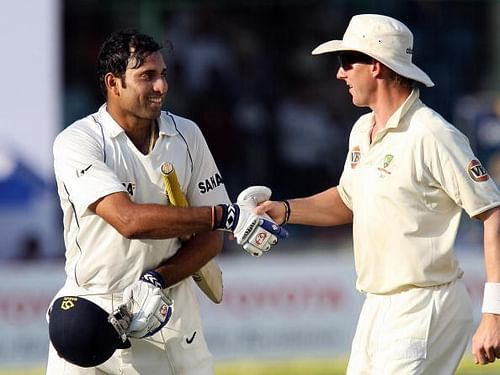
The genius of the Very, Very Special Laxman

“Watch him, but don’t try to imitate him—only VVS can play them [strokes],” was former India coach John Wright’s assessment of him. Laxman was indeed something else entirely. You could emulate Virender Sehwag’s hand-eye hitting or Sachin’s silkily balanced style. Heck, you could even have that unorthodox back-lift of Rahul Dravid if you tried hard.
However, in the case of Laxman, there was him and him alone.
In a world where everything moves at a frantic pace, Laxman always found ample of time to play his strokes with utmost guile. It was like meditation while batting: breathe in, hold the stance and play the stroke while breathing out slowly.
There was an aura of class that floated in the air that surrounded him when he took his stance on the crease. He stood like an emperor, resembling Alexander the Great, among the other 14 men on the ground.
His bat was a sword that he wielded like a painter weaving an exquisite portrait by colliding the colours. It wasn’t batting, it wasn’t hitting the ball…it was pure art. Pure, majestic art.
In an era that consisted of Sachin Tendulkar, Rahul Dravid, Sourav Ganguly and Virender Sehwag for team-mates, Laxman was never really surrounded by the limelight. And, frankly, he never cared. All he ever thought about contributing for the team.
He played an awkward role, one that perhaps made even hope that he didn’t arrive early to bat. Batting at number 6, his job was to give the finishing touch to the innings. But if only it was exclusive to that.
The last hope
Sehwag is gone? No problem, Dravid’s is there. Dravid’s out too? Doesn’t matter, there is Sachin. Oh, now even Sachin is gone? The Royal Tiger of Bengal, the captain Ganguly roars in. But he’s gone too? No fear when Laxman is here. VVS is walking back to the pavilion? Well, all hope is gone now.
That was his role: he was always the last hope when all others failed—and, most of the time, he delivered.
Batting at 6 was never easy. If any of the top 4 big names did well, it meant that Laxman never really got the chance to stay long enough in the crease and play a big innings. And if all of the others failed, then he found himself batting with the tail under enormous pressure, again with not much time in hand, given that the lower-order almost always fell like a pack of cards.
Under such circumstances, VVS’ numbers are more than impressive. An average of 45.97 doesn’t do justice to his class, but under the conditions he almost always played, it was more than terrific.
Finishing this article without once mentioning THAT innings against Australia would book me a place in the eternal rungs of hell, a sin I wouldn’t commit. That day, along with Dravid, he entwined a tempest to which the Aussies had no answer, except for surrendering the control and let themselves get consumed in the chaos.
Almost every story of the origin of the universe in mythology has chaos as the root of creation. On that fateful day, his 281 runs gave birth to a different type of class amidst the mayhem of the Kangaroos—one that, to this day, is fondly remembered by Indian fans.
“If you get Dravid, great. If you get Sachin, brilliant. But if you get Laxman, it is a miracle,” these were the wise words used by Steve Waugh to instruct Brett Lee. It just goes to show how he stamped his name in the game. When conditions got the toughest, Laxman—the toughest and most competitive—got going.
Laxman won’t score you runs at a blazing pace like AB de Villiers, neither does he possess the fieriness of Virat Kohli, but what Laxman can do, only the Lord Almighty can replicate with enough practice.